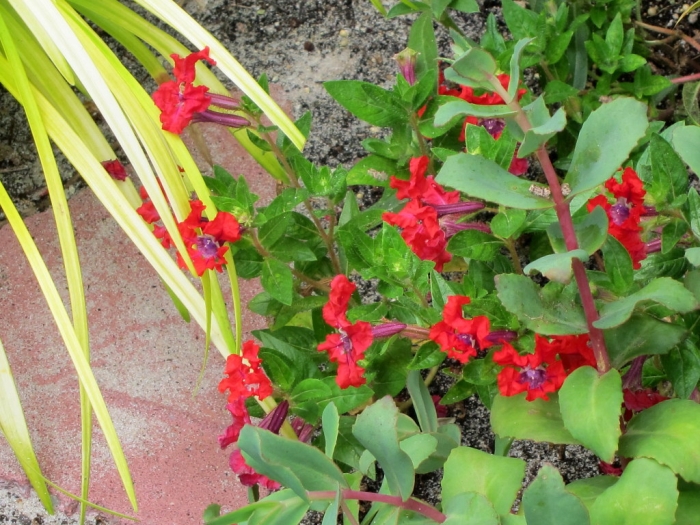Bat-Faced Cuphea
(Cuphea llavea)
Bat-Faced Cuphea (Cuphea llavea)
/
/

cultivar413
CC BY 2.0
Image By:
cultivar413
Recorded By:
Copyright:
CC BY 2.0
Copyright Notice:
Photo by: cultivar413 | License Type: CC BY 2.0 | License URL: https://creativecommons.org/licenses/by-sa/2.0/ | Uploader: cultivar413 | Publisher: Flickr |

























Estimated Native Range
Summary
Cuphea llavea, commonly known as Bat-Faced Cuphea, is an evergreen subshrub native to open woodlands and scrub areas in Mexico. It typically grows to a height and width of 2-3 feet (0.6-0.9 meters), forming a dense, bushy mound. The unique flowers, resembling a bat’s face, are a striking combination of black and dark purple calyxes with two bright red petal lobes, blooming prolifically throughout the year in its native range and in warm climates. The flowers are highly ornamental and attract pollinators such as hummingbirds and butterflies.
Bat-Faced Cuphea is valued for its continuous flowering, especially in warm climates where it can bloom year-round. It is well-suited for use in borders, containers, and as an accent plant in tropical and subtropical gardens. This plant prefers full sun but can tolerate partial shade, and while it needs regular watering, it is relatively drought-tolerant once established. It thrives in well-draining soil and is generally low-maintenance, requiring only occasional pruning to maintain its shape. There are no major disease problems, but it can be susceptible to root rot if overwatered. It is not known to be invasive and does not have aggressive roots, making it a safe choice for a variety of garden settings.CC BY-SA 4.0
Bat-Faced Cuphea is valued for its continuous flowering, especially in warm climates where it can bloom year-round. It is well-suited for use in borders, containers, and as an accent plant in tropical and subtropical gardens. This plant prefers full sun but can tolerate partial shade, and while it needs regular watering, it is relatively drought-tolerant once established. It thrives in well-draining soil and is generally low-maintenance, requiring only occasional pruning to maintain its shape. There are no major disease problems, but it can be susceptible to root rot if overwatered. It is not known to be invasive and does not have aggressive roots, making it a safe choice for a variety of garden settings.CC BY-SA 4.0
Plant Description
- Plant Type: Subshrub
- Height: 1.5-2.5 feet
- Width: 2-3 feet
- Growth Rate: Moderate
- Flower Color: Black, Purple, Red
- Flowering Season: Spring, Summer, Fall
- Leaf Retention: Evergreen
Growth Requirements
- Sun: Full Sun
- Water: Medium
- Drainage: Medium
Common Uses
Bee Garden, Bird Garden, Border Plant, Butterfly Garden, Drought Tolerant, Groundcover, Hummingbird Garden, Low Maintenance, Potted Plant, Rock Garden, Street Planting
Natural Habitat
Open woodlands and scrub areas in Mexico
Other Names
Common Names: Tiny-Mice, Cuphea, Flamenco, Kolibriblomster, Litet Kolibriblomster, Cúfea
Scientific Names: , Cuphea llavea, Cuphea llavea var. llavea, Cuphea miniata, Cuphea speciosa, Cuphea llavea var. miniata, Cuphea blepharophylla, Parsonsia blepharophylla, Cuphea llavea f. barbigera, Cuphea llavea var. barbigera
GBIF Accepted Name: Cuphea llavea Lex.